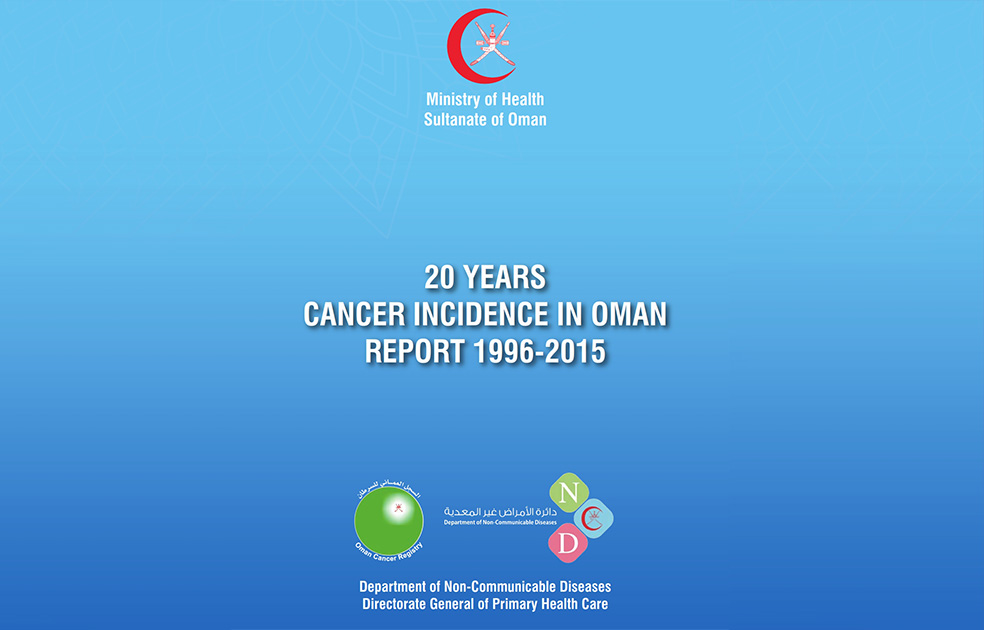
Introduction: Oman’s journey towards understanding and controlling cancer trends
Oman recently celebrated the 20th anniversary of its population-based cancer registry, a significant milestone in the country's efforts to fight cancer. With cancer being recognized as a major health issue in Oman, the establishment of this registry in 1996 was a crucial step towards understanding and controlling cancer trends. The registry has played a vital role in providing valuable information for cancer control initiatives and has influenced various programmes aimed at early detection and treatment. Consistently publishing annual reports on cancer incidence in Oman, it offers valuable insights that have shaped the integration of breast cancer screenings in primary healthcare, the implementation of a nationwide breast cancer screening campaign and the formation of a colorectal taskforce. This narrative explores the journey of Oman's population-based cancer registry, the challenges faced, the impact it has made and the future steps envisioned.
Context: Oman's health system, oncology centre and cancer registry
Oman's health system. The health system in the Sultanate of Oman is known for its universal coverage, providing free primary healthcare for Omani citizens and subsidized care for expatriates. Over time, noncommunicable diseases (NCDs), including cardiovascular diseases, cancer, diabetes and chronic respiratory diseases have emerged as a significant burden. Recognizing cancer as a major health concern, Oman implemented a cancer surveillance system through a population-based registry. This registry plays a vital role in capturing cancer incidence data from various sources, such as hospitals, pathology laboratories and death certificates, offering an unbiased profile of the cancer burden and its changes over time.
Inauguration of the National Oncology Centre. In December 2004, the Ministry of Health celebrated the inauguration of the National Oncology Centre at the Royal Hospital. With the addition of radiotherapy services to the existing surgical and chemotherapy facilities, Oman aimed to enhance cancer treatment options within the country.
Establishment of the population-based cancer registry. Oman's national cancer registry was initially established as a hospital-based registry in 1985. In 1996, it transitioned into a population-based registry under the Department of Noncommunicable Diseases. During this year, the registry released its first report on Cancer Incidence in Oman. The registry's primary objective was to monitor cancer patterns, evaluate incidence trends and provide policymakers with a comprehensive database for cancer prevention and control prioritization.
Since 1996, annual reports on cancer incidence in Oman have been published, showcasing the country's cancer data internationally. In 2002 and 2007, Oman's cancer data were featured in the publication "Cancer Incidence in Five Continents", appearing in Volume VIII and Volume IX respectively. Then, in October 2019, a comprehensive report was published, incorporating two decades of cancer incidence data in Oman. This significant release marked the 20th anniversary since the initial publication of the cancer incidence report.
Challenges and lessons learnt: Advancements, data enhancements and enduring obstacles
Over the years, the registry has undergone significant changes to improve data collection, quality and reporting. Currently, a dedicated team consisting of three full-time registrars, a public health specialist and the Director of the Noncommunicable Diseases Department oversees the registry. Data collection employs both active methods, where the cancer registry staff actively collects information from various sources, and passive methods, which rely on health workers to fill out notification forms. Additionally, an electronic system for notifying cancer cases has been established to encourage health workers to submit notifications passively.
In 2016, the database underwent a transformation and was migrated to the CanReg5 software. This migration has played a vital role in enhancing the quality of data by implementing internal checks and increasing the percentage of morphologically verified diagnosed cases. Furthermore, electronic access to a wide range of information, including patient demographics, treatment details and death information (in cases where death occurs in the hospital), is now available through the Al-Shifa Hospital Information System. This system caters to both in-patients and outpatients with cancer, ensuring comprehensive access to relevant data.
However, challenges persist, including a shortage of human resources and the absence of linkage between the cancer registry and the mortality database, which hinders the estimation of survival rates.
Impact: Transforming cancer care
The cancer registry's invaluable information spanning two decades has shed light on the incidence of cancer in Oman. Notably, breast and colorectal cancers emerged as the most common types. As a result, several initiatives were undertaken, including the integration of breast examination into primary healthcare facilities, a nationwide campaign on early detection of breast cancer conducted across all governorates, and the establishment of a taskforce to develop guidelines for colorectal cancer screening and management. These actions exemplify how data from the registry can drive evidence-based decision-making and lead to tangible improvements in cancer care.
Next steps: Integrating mortality data and calculating survival rates
The cancer registry team is currently focused on establishing access to national mortality data and linking the death registry with the cancer registry. This integration will enable the identification of unreported cancer cases and facilitate the calculation of survival rates. By addressing these crucial steps, Oman aims to further enhance its understanding of cancer incidence and improve outcomes for individuals affected by the disease.
Story originated in 2019.


